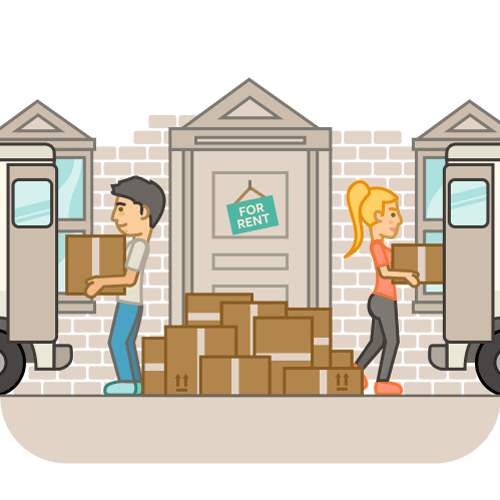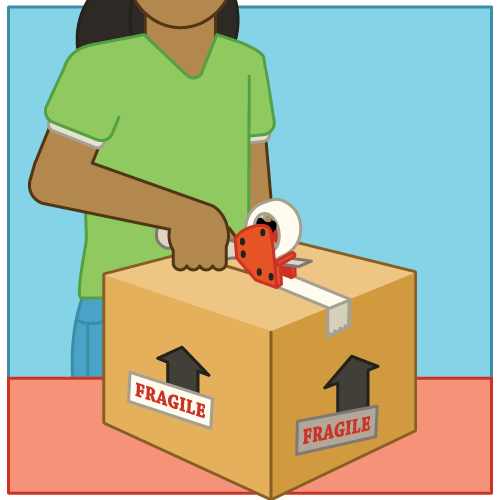 Although buying or selling a home can be an exciting adventure, it’s also a time-consuming (and in the case of the former, expensive) process. So, when it comes to selecting a person to oversee the purchase or sale from your end, knowing how to find the right agent is key to your success and your sanity. At Moveline, we’ve helped lots of folks move lots of places, and especially for first-time homebuyers and sellers, we’ve got some pointers for choosing the best person for the job.
Although buying or selling a home can be an exciting adventure, it’s also a time-consuming (and in the case of the former, expensive) process. So, when it comes to selecting a person to oversee the purchase or sale from your end, knowing how to find the right agent is key to your success and your sanity. At Moveline, we’ve helped lots of folks move lots of places, and especially for first-time homebuyers and sellers, we’ve got some pointers for choosing the best person for the job.
Realtor vs. agent vs. broker
The National Association of Realtors (NAR) reports a total of 4.87 million home sales (not including new construction) in 2013. That’s a lot of bricks and mortar, and an awful lot of negotiations, inspections and paperwork to go along with it. Luckily, the US has around 2.5 million agents and brokers to choose from, about half of whom are NAR members, or “Realtors.” It’s important to note that all Realtors are agents or brokers, while not all agents and brokers are Realtors; the distinction comes with NAR membership. Some agents, for instance, may work exclusively for a developer and may not need access to the MLS (the national database which is run by the association and used religiously in most home searches). So if you’ve got your heart set on a pre-construction condo in a particular building, for example, you may not need a Realtor, and the developer’s sales agent might be just fine for you. If you’re doing a broader home search or sale, though, your best bet is to go with a Board-certified Realtor who’s held to the professional standards of their peers, and who can use the MLS to get up-to-the-minute info on homes in your market.
Oh, and a broker? That’s simply a term for a person who passed his or her state’s broker exam and owns (or has owned) a real estate business.
Use word of mouth
It could be argued that the best Realtors and agents bring in the majority of their clients through word of mouth — like any other industry, the proof is in the pudding, and satisfied customers are often a great indicator of a professional’s value. If any friends or family members have bought or sold a home in your city or town in the past few years, ask them who they worked with and whether or not they would hire them again. Bear in mind, of course, that different agents have different areas of expertise and levels of familiarity with different parts of town and types of homes, so make sure that weighs in on your decision as well. The agent who found your parents their dream retirement home on the outskirts of town might not be the best choice to help you snag that trendy loft downtown, and vice-versa, so be sure to balance personal recommendations with other professional strengths.
Weigh your options
Real estate agents are, first and foremost, salespeople, so it’s their job to convince you to buy something. If you’re buying, the best agents won’t force you into anything beyond your price range or ask you to change your home search parameters unless you’re genuinely asking for the moon with nary the money to pay for it. A qualified professional will take your priorities into consideration and offer suggestions based on what you want — not what they want for you. And if you’re selling, the best agents will give you realistic advice on the kind of figure your home can fetch and why — after all, if you don’t make a purchase or a sale, there’s no benefit for them in the end.
To determine an agent’s communication style, compatibility level and depth of experience, it’s important to research them online (Yelp and Angie’s List are often great resources) and in person. If you don’t find someone based on a friendly recommendation, use a home search tool like Zillow, Trulia or Redfin to locate open houses in your area, and then take a day or two to visit some. Talk with the agent at each home and, if you’re interested, dig a little about their experience buying or selling the sort of home you’re looking for or looking to sell, find out how long they’ve been practicing real estate, and ask them for references. Generally, the more closings they’ve got under their belt, the better. You can ask for a list of their recent transactions to get a sense of how busy they are — not to mention how familiar they are with homes like the one you’re hoping to get into or out of.
Next, when you’ve narrowed your agent search down to two or three top candidates, invite them out for coffee or lunch to get to know them a little better. Take this list of homebuyer questions with you to help you along. And a pro tip: if you can meet them during business hours on a weekday, it may be easier to spend a bit more time with them and command their full attention, as their early evenings and weekends are likely filled to the brim — hopefully, anyway — with open houses and client appointments.
Trust your gut
As in any situation where loads of money are concerned, your instincts shouldn’t be ignored. If someone looks great on paper but just feels strange or disingenuine, pay attention to your sixth sense. If someone hasn’t been practicing for very long but seems particularly sharp, ethical and dedicated, it might be worth giving them a chance. Do your due diligence in checking out your options before you settle on anyone in particular, and hold them to a reasonable professional standard when it comes to giving you honest answers, providing valuable insights and being consistently available throughout the entire process.
And once you’re ready to move into the home you’ve purchased or out of the one you’ve sold, Moveline can take the stress out of the process, securing the best moving services at the best prices and making sure to have your back every step of the way. Isn’t it nice to have good people on your side in a stressful situation? We think so, too. That’s why we’re here.
 It’s tempting to cut ties and go on a far-flung adventure, starting fresh and leaving it all behind, but let’s be honest: life’s not like the movies. While a clean slate may eventually be just what the doctor ordered, for the time being it’s important to have lots of emotional support, and moving to a new city may actually prolong the healing process. The newness of an unfamiliar place can be invigorating at first, but the isolation that comes with it can make for a pretty swift comedown once reality sets in. And especially where children are involved, a well-thought-out plan needs to be set in place far in advance of a relocation — one that holds the kiddos’ best interests in high regard. So, bide your time before you set off into the great blue yonder and start the next chapter of your life. Spend whatever time you need to grieve the end of the relationship; be available for whatever loose ends need to be tied up with divorce proceedings, child custody agreements and the like; and do yourself a solid by not completely upending your life in the middle of it all. There’ll be time for new beginnings soon enough.
It’s tempting to cut ties and go on a far-flung adventure, starting fresh and leaving it all behind, but let’s be honest: life’s not like the movies. While a clean slate may eventually be just what the doctor ordered, for the time being it’s important to have lots of emotional support, and moving to a new city may actually prolong the healing process. The newness of an unfamiliar place can be invigorating at first, but the isolation that comes with it can make for a pretty swift comedown once reality sets in. And especially where children are involved, a well-thought-out plan needs to be set in place far in advance of a relocation — one that holds the kiddos’ best interests in high regard. So, bide your time before you set off into the great blue yonder and start the next chapter of your life. Spend whatever time you need to grieve the end of the relationship; be available for whatever loose ends need to be tied up with divorce proceedings, child custody agreements and the like; and do yourself a solid by not completely upending your life in the middle of it all. There’ll be time for new beginnings soon enough.
Do:
Redefine your sense of home
If you’re staying behind in the home you once shared with someone, now’s a fantastic time to make it completely yours. While the divorce process and/or the transition to paying all the bills yourself (if you were sharing them previously) can be expensive, a little goes a long way when it comes to making your surroundings as comforting as possible. A fresh coat of paint, for example, may not solve all of life’s problems, but in a small way, it can signify a moment of reclaiming something for yourself, and of making a decision based purely on what you want.
If you’re moving to a new place, give yourself permission to take pleasure in decorating it with things that bring you joy. As strange as it might sound, making your space completely your own can actually be empowering. And even if you’ve just signed a short-term apartment lease and don’t plan on staying there for long, the space itself doesn’t have to feel like a compromise. A few simple short-term decorating tips can help you make it feel more like home without biting into your security deposit — or your bank account.
Take the time you need
Regardless of what anyone tells you, there’s no magic timeframe for getting over a relationship. If you’re able to move on quickly, great. If it takes longer than you’d hoped, that’s okay too. If a few months go by and you’re ready to set down more permanent roots in a place that feels comfortable to you, go for it. If you need to renew that lease until you figure out what’s next, that’s perfectly fine too. Only you know what feels best for you, and how you choose to take your next step in life is up to you and you alone.
When the time comes to pack up your stuff and move on to whatever’s next, Moveline can help ease the stress of the move. Because technology is awesome, and it’s just like the late, great Albert Einstein once said: “Life is like riding a bicycle. To keep your balance, you must keep moving.”
 Moving, in and of itself, is stressful enough. Add in the (very real) possibility of being taken for a ride, both literally and figuratively, by a rogue mover and it’s enough to drive even the sanest person to pull their hair out. But never fear! The pros at Moveline have some expert tips to help you avoid moving scams. Read on to stay scam-free.
Moving, in and of itself, is stressful enough. Add in the (very real) possibility of being taken for a ride, both literally and figuratively, by a rogue mover and it’s enough to drive even the sanest person to pull their hair out. But never fear! The pros at Moveline have some expert tips to help you avoid moving scams. Read on to stay scam-free.
First, your new best friend should become this website. It’s run by the US Department of Transportation and is the go-to spot for making sure everything about your move is on the up and up.
Second, one of Moveline’s resident experts, Susanna Walsh, has the skinny on the three things to look out for in order to avoid getting tangled up with the wrong kind of movers:
- Nothing up-front. If you’re ever asked for a deposit or to pay cash up-front, even if it’s small, hang up! Think of booking a move like reserving a hotel room: it’s cool if they take your credit card number and hold it, but charging anything before you actually show up to the hotel (or, in this case, any earlier than a day or two before moving day) doesn’t jive.
- Inventory is essential. If anyone gives you a quote without seeing your stuff, or at least doing a phone or online checklist inventory, that’s… just not possible. There are a ton of quirks to pricing which depend completely on the total of your specific stuff in either cubic feet or weight, especially when it comes to a long-distance move. If a company offers to give you a flat rate based on something like the size or type of place you live in, it’s pretty much guaranteed to be a scam.
- Get the numbers. Every moving company is required to have either a Department of Transportation (DOT) or Motor Carrier (MC) number. If they say they don’t (and especially if you check them out and they actually don’t), then they’re not registered with the US government. If you do get a number, check it out here. Look at the Entity Type and Operating Status fields to make sure they’re listed as a carrier. Make sure there’s an X next to “Authorized for Hire” and alongside any other relevant line items, If the company says they can handle your interstate move but they aren’t marked as an interstate mover, for example, it means your move will definitely be contracted out to another company.
The bottom line: if it seems too good to be true, it probably is. If you’re ever unsure, just call Moveline. Ask us all the questions you want — we’ll never charge for a consultation. We can give you pointers on anything from how to move with a pet to how much ducks weigh, and offer tips for things like meeting your new neighbors along the way.
And by the way: if you do go with Moveline, we’ll take care of your inventory with our handy app.. Take a look and get moving now.
 Whether it’s across town or across the country, Moveline will help get your stuff where it needs to be safely and on time. But if you’re a parent, your most valuable possessions won’t be on the moving truck. Your child may need a little extra care and planning when it comes to moving, even if her new bedroom is waiting just a few ZIP codes away. Here, some tips for making a move with kids as painless and stress-free as possible:
Whether it’s across town or across the country, Moveline will help get your stuff where it needs to be safely and on time. But if you’re a parent, your most valuable possessions won’t be on the moving truck. Your child may need a little extra care and planning when it comes to moving, even if her new bedroom is waiting just a few ZIP codes away. Here, some tips for making a move with kids as painless and stress-free as possible:
Explain, explain, explain
Your child or children probably didn’t have any input in the decision to move, which can make them feel a bit powerless. To lessen the impact of those feelings, give as much information as possible, as soon as possible.
- Plan a good time to break the news, perhaps around a favorite meal. Explain the why, when, where and what to expect before, during and after the move. (Will she be packing her own things? What can go with him in the car and what goes on the truck? Will you be donating some of their old clothes and toys before you go?)
- Be honest. Regardless of age, knowing the details – both positive and potentially negative – will help your child feel less out of control, especially if this is their first time moving.
- Open the floor for questions and remain positive and non-defensive as you answer, validating her concerns. Be prepared to answer some of the same inquiries over and over again as the move date approaches. Kids, as we all know, often ask more questions when they’re looking for reassurance.
Plan ahead
If you’re still in the process of choosing a new home, consider what each of the potential locations will mean for your child. Where’s the closest day care? What school district will you be in? (If it’s still up in the air, here are some tips on choosing a school.) Does your new neighborhood have sidewalks? Where’s the nearest park? Family doctor? Once you’ve made your decision and your new place is definite, report any exciting finds to your kids to help them look forward to the change.
Set the tone
From beginning to end, try to maintain a positive attitude about the move and your child will often take your lead. Be realistic, but focus on the benefits of moving and of your new home. A little adventure can actually be a lot of fun, but it’s up to you to make sure they know that.
Keep the routines
Kids thrive on routine, familiarity and consistency. The unfamiliar is usually a little scary, so an across-town move can be confusing, while a big move to a new city or state can feel like a major disturbance, which could equal major stress for you! As best you can, maintain typical wake-up, mealtime and bedtime routines. If it’s possible, avoid introducing other life changes during this time, like potty training or transitioning to a big-kid bed. When you arrive in your new home, make getting your child’s bedroom in working order a priority.
Give ‘em a job
Giving kids a sense of purpose during the move is a great way to include them in the process. Tell them you’re depending on them to help you do a very important job and then offer a choice of two or three tasks. Listed by age-appropriate levels, here are a few ideas for moving jobs that are perfect for littler hands:
For younger kids:
- Small cleaning projects, like wiping countertops or windows
- Pack the clothes she’ll need for the first few days
- Decorate and fill a small box of important treasures that will stay with him on the way to the new home instead of going on the moving truck
For older kids:
- Make “keep,” “donate” and “sell” piles of toys, books and other belongings
- Take charge of a younger sibling
- Bring home a meal for everyone
- Minor home repairs, like removing finishing nails or touching up paint
- Make a detailed plan for her new room or living space, including paint colors
Make new memories
Especially if you use Moveline to help you find the right mover at the best price, you’ll be moved in before you know it, scratching your head over how easy it all was. With all the time you saved, your family can get started on putting down roots in your new environment. Participating in teams, clubs or activities hosted by schools or places of worship is a great way for everyone to feel connected more quickly. You may even want to sign yourself up for a free or low-cost pottery class or kickball league at your local recreation center or join a volunteer organization as a way of investing in your new community and making grownup friends in your area (or click here for a host of other ideas). And last but not least: a couple of fun storybooks to help your kids understand moving — Big Ernie’s New Home: A Story for Children Who Are Moving and The Berenstain Bears’ Moving Day. Because reading is fundamental, and so is the security of not feeling scared or alone in the midst of a move.
Let Moveline get your family from point A to point B without a hassle. Check us out and get started here.
Today is a hard day for Moveline. Unfortunately, we’ve had to lay off many of our team members as we shift in strategy to focus on developing a more efficient product line. Doing so is extremely difficult but is a necessary measure to set Moveline up for success in the future.
For the last 18 months, Moveline has been pursuing a strategy of using our technology to offer a broad variety of services to our customers and working with a wide range of moving company partners to accomplish this. Based on early success in this model, we began to aggressively grow the company and further expand our reach in the market. We rapidly hired talented Moveliners to support our customers with this mission.
But, as many startups do, we experienced growing pains in scaling the business this way and, after learning from this approach, have decided that it’s best for us to narrow our focus to what we’re best at.
We’ve decided to streamline our service offering and are making some changes to our product to suit a simpler, more satisfying moving experience. Doing so also required that we make some staffing adjustments and as a result, we had to say goodbye to some very talented Moveliners in order to more closely align with our service moving forward.
There’s no doubt this is a turning point in our business but I’m excited about Moveline’s future and confident that with the team we have in place and a fresh perspective on how to sustainably grow our company, we’ll be a stronger Moveline, capable of delivering an even better moving experience to our customers.
It would be an incredible understatement to say that I’ve learned a lot from this experience and I want to thank everyone for the dedication and the commitment they’ve invested in Moveline as we begin looking forward into the next phase.
 We live in a do-it-yourself kind of world. From home improvements to tech gadgets galore, there’s not much we can’t at least attempt to accomplish on our own, and for a lot of folks, moving is one of those things. While hiring a professional mover can often be the wiser (and, surprisingly, cheaper) choice, a majority of people prefer to pack their own belongings instead of opting to let the pros do it. If that’s the case for you, don’t lift a finger before reading these five quick tips from the top-notch team here at Moveline to keep your stuff — and your sanity — in one piece before, during and after a move.
We live in a do-it-yourself kind of world. From home improvements to tech gadgets galore, there’s not much we can’t at least attempt to accomplish on our own, and for a lot of folks, moving is one of those things. While hiring a professional mover can often be the wiser (and, surprisingly, cheaper) choice, a majority of people prefer to pack their own belongings instead of opting to let the pros do it. If that’s the case for you, don’t lift a finger before reading these five quick tips from the top-notch team here at Moveline to keep your stuff — and your sanity — in one piece before, during and after a move.
1. Don’t procrastinate
This one’s easy to preach but hard to live by. Truly, though — if you’ve got a full weekend to devote to getting ready for the move, use it. It may not seem like a big deal to “just throw everything into a few boxes,” but many are the men and women who have underestimated the time it takes to properly prepare themselves to move their entire lives into a completely new living space. Make a game of it if you have to: set an egg timer for 30 minutes, an hour, or whatever length of time you’d like, and challenge yourself to pack up 5 boxes, or an entire room, or whatever your goal may be. Repeat, and repeat again, until poof! You’re all done.
2. Ask for help
The Beatles most famously said, “I get by with a little help from my friends.” They said a lot of other stuff, too, but when you’re faced with a mountain of boxes or crates and a looming move-out date, it’s probably the best advice you could follow. Use these tips for throwing a packing party and get the job finished in one-third, one-fourth or even one-fifth the time it would have taken if you’d gone it alone.
And a pro tip: if you’re having trouble finding boxes and/or don’t know what to do with them when you’re through, you’re just one Google search away from the eco-friendly option of renting plastic crates. Many companies offer delivery and pickup, and they’re often cheaper than buying cardboard. The planet and your wallet will both thank you.
3. Label and color-code everything
Once they’re on the truck — whether it’s one you rented and are driving yourself, or one operated by moving professionals — most of those boxes are going to look awfully similar to one another, if not completely identical. Particularly if your move is a large one, don’t just scrawl the name of the room each box belongs in; add a few short bullet points afterward (coffee mugs, utensils, tupperware or textbooks, tax files, stationery, for instance).
Better yet, consider using a different color packing tape (or just spread a line of washi tape across a few sides of each box, again switching up the color or pattern for each room) for each room, just to make the load-in process that much easier, as well as the act of keeping your sanity as you try to get out of those boxes as quickly as possible in your new place.
4. Protect your breakables
This may sound elementary, but when you’re in the eleventh hour and don’t much care to spend extra time carefully wrapping those valuables, it’s all too easy to forget how much jostling (and bumping, and cracking, and shattering) just might take place during transit. So do yourself a favor and pack with an abundance of caution, making merry use of specialty boxes (wardrobe, wine glass, etc), bubble wrap, paper, and any other materials that can shield your possessions from destruction between your old home and your new one.
Oh, and we’ve got special tips to keep you sane and your stuff intact if you’re packing electronics or fine china. You’re welcome.
5. Don’t pack immediate essentials
Packing up that bathroom with one big swipe of your arm across the countertop? Not so fast. You’re gonna need toothpaste, face wash, daily meds, and so on within the first 24 hours of moving into the new space, so leave those out where they’re easily accessible. Likewise when it comes to Fido’s food, leash and waste bags, as well as plenty of other items you might need to access during or shortly after the move.
To make life a little easier, here’s a helpful list of documents to keep on hand (you know, just in case), as well as a checklist of what to keep handy on moving day, just to get you through the first day or two after your stuff comes off the truck.
Last but not least, if you’re hiring a mover for a local or long-distance move, let Moveline help. We compare prices, help you secure the best mover for the job, and lock in your rates so you’re not hit with any surprises in the middle of one of life’s most stressful events. Don’t go it alone. Let us help.
 Moving to Atlanta? The first thing you should probably know about your soon-to-be home is that in just about any ranking of US cities with the most sprawl, Atlanta takes the top slot. That means that one of the top considerations when you’re looking for short-term housing (and long-term as well) is your commute. Luckily, here at Moveline, we’ve overseen our fair share of local and long-distance moves, and we’ve got tips for all sorts of places and living situations, including temporary housing in Atlanta.
Moving to Atlanta? The first thing you should probably know about your soon-to-be home is that in just about any ranking of US cities with the most sprawl, Atlanta takes the top slot. That means that one of the top considerations when you’re looking for short-term housing (and long-term as well) is your commute. Luckily, here at Moveline, we’ve overseen our fair share of local and long-distance moves, and we’ve got tips for all sorts of places and living situations, including temporary housing in Atlanta.
First up: a tip on getting from point A to point B. Roone Unger, a contractor and owner of Exovations, a home improvement company in Atlanta, knows the unofficial capital of the south well. “If you can cut down on your commute time,” he says, “you’ll be happier and have more time to explore beautiful Atlanta. Keep in mind there is one major Interstate that runs through the city. It seems that no matter what part of 85 you are on or at what time of day, there is always some sort of delay. If you are able to take public transportation, look into that. If you don’t have a car, look for a place near a MARTA (Metropolitan Atlanta Rapid Transit Authority) station; trains run through the city and there are buses that connect some suburbs to downtown.”
Get an overview of Atlanta neighborhoods
Before you begin your search for a place to stay, get familiar with Atlanta by checking out Curbed’s Atlanta page. Covering the city’s real estate market, it gives a feel for some of the city’s neighborhoods. A recently-posted, decidedly politically incorrect, annotated neighborhood map which originally appeared anonymously on Reddit gives a no-holds-barred glimpse at the city’s neighborhood stereotypes. For its part, Curbed warns that it’s guaranteed to offend just about everyone.
Two other, more tonally straightforward sites to help orient newcomers to Atlanta are Trover and CoEverywhere. Trover lets you see photos of what people who live in a particular neighborhood like best — galleries, food shops, parks, etc. CoEverywhere lets you draw a circle around the area you want to explore and connects you to its real-time social media activity, including tweets, facebook posts, photos and more.
Reach out to friends (and friends of friends)
Speaking of social networks, they’re a vital part of any relocation. Telling all your contacts that you’re moving to Atlanta and looking for short-term housing can often cut out a lot of extra work. If you’ve got serendipity on your side, your search might go as smoothly as Thomas Nitzsche’s: he relocated to Atlanta from St. Louis for a job in early 2014. After checking out three places he’d found on Craigslist.com that ultimately weren’t what he wanted, he took a lunch break. The person he had lunch with — someone he’d met through a social app — turned out to have a home with a detached furnished carriage house in the Virginia Highland neighborhood, and he’d just decided to rent out. “It’s one of the best areas of the city,” Nitzsche says. “A few weeks later, I moved into it.”
Use online short-term stay resources
If you come up empty from your word-of-mouth campaign, you can always lean on those two old standbys, Craigslist and airbnb. A recent Craigslist search came up with a share in a recently renovated 900-square-foot two-bedroom condo near Peachtree Center for $500 per month. On airbnb, a 925-square-foot one bedroom plus sunroom sublet furnished in mid-century modern style and located across the street from Georgia State runs $2137 per month as of this posting.
If you’re unable (or too creeped out) to check out listings for yourself, you can get the folks at golook.com to scope out possibilities for you. Services, including a full report, start at $59.
The national site sublet.com is also worth a look. Two recent Atlanta listings included a one-bedroom in midtown near Piedmont park for $1220 including utilities and a totally renovated two-bedroom house in Buckhead with a big backyard or $4200 a month.
Other good places to look: atlanta.apartmenthomeliving.com, ListLux and Uloop (which specializes in properties near colleges and universities). And for sublets available primarily to academics, take a look at Sabbatical Homes, a site founded in 2000 by Nadege Conger, a professor’s wife who now runs the growing operation with the help of a multi-national team.
Find a roommate
Need help finding a roommate? Three nationwide sites that can help are roomster.com, roommates.com and roomiematch.com, and Atlanta’s own Roommate Locator can too. ListLux and Uloop, listed above, also offer listings with roommates from time to time.
 Love is a many splendored thing… at least most of the time, right? When the time rolls around to start cohabitating, though, that’s when one of the many true challenges of a relationship can rear its ugly head, testing the mettle of even the schmoopiest of lovebirds. So, we’ve put together the ultimate guide for couples moving in together. It’s chock full of statistics, anecdotes, tips and advice. But for the “tl;dr” crowd, we’ve synthesized those points into a short blog post for your speed-reading pleasure. Here, a quick rundown of the dos and don’ts of moving for a relationship.
Love is a many splendored thing… at least most of the time, right? When the time rolls around to start cohabitating, though, that’s when one of the many true challenges of a relationship can rear its ugly head, testing the mettle of even the schmoopiest of lovebirds. So, we’ve put together the ultimate guide for couples moving in together. It’s chock full of statistics, anecdotes, tips and advice. But for the “tl;dr” crowd, we’ve synthesized those points into a short blog post for your speed-reading pleasure. Here, a quick rundown of the dos and don’ts of moving for a relationship.
Know thyself
Moving across town to share an apartment with your favorite person is a big enough step on its own, but if you’re making a long-distance move, it’s imperative to ask yourself what a full-fledged relocation will do to the aspects of your life outside of your relationship. Will it hurt your career? Make it tough to stay in touch with friends and family? Sever your ties to people, places and things that are important to you? If so, think long and hard before you make the leap. The Moveline team isn’t made of relationship experts, but moving is indeed our specialty, which means we’ve met lots of people under lots of stress. Make sure you ask yourself if your bond with your significant other is strong enough to withstand all of it. (And make sure you ask them, too.)
Divide and conquer
So you’re a traditional homebody with an antique leather couch and a couple thousand books, moving in with a globetrotting minimalist whose only earthly possessions are a laptop, a futon and a suitcase? This might call for a compromise or two, on everything from decorating your space to setting realistic expectations of what your life under the same roof will be like.
Yeah, yeah, we know opposites attract and love conquers all, but you can probably avoid a few epic fights just by being open about your desires and expectations before you ever pack a box. Figure out well in advance what earthly possessions are most important to each of you vs. what can be given away, repurposed into something else or sold on Craigslist, and talk openly about what you want life together to be like. Early mornings and cozy evenings in, or all-night parties and wild weekend roadtrips? Half the fun of moving in together is learning each other’s hidden quirks, but before the novelty wears off, figure out how to meet in the middle, give one another space and respect each other as individuals. That’s how the strongest relationships thrive.
Figure out those finances
It’s long been said that money is the leading cause of divorce, and probably often breakups too. So sit down with the object of your affection and don’t just figure out the monthly budget (i.e., Are you going 50/50 on rent? Who pays for toilet paper/coffee beans/Netflix? Whose name goes on the utilities bill?); ask those deep, sometimes uncomfortable questions about how each of you deals with your dollars. The Motley Fool offers a great, free exercise (requiring just an email sign-up) to help you clear the air with one another about your attitudes toward money and how you spend it. Conversations like these can help you better understand where your future challenges might lie and give you the tools you need to cut them off at the pass.
Most importantly, keep the lines of communication open about everything under the sun. Check out our guide for detailed advice on moving for love, and of course, enlist Moveline’s help when it comes time to hire a mover and get going. We’ll help you compare movers, hire the right one, and save money, time and stress along the way. Because who wants to waste extra energy on all that stuff when there’s a his-and-hers (or his-and-his, or hers-and-hers) nest out there, just waiting to be yours together?
 In such an age of excess, the environmentally conscious among us can get a little nervous when it comes to outfitting a new home with all-new furniture and decorations to match. That’s why it’s such good news that there are so many resources online that champion creative reuse projects, showing us ingenious ways to transform one thing into another.
In such an age of excess, the environmentally conscious among us can get a little nervous when it comes to outfitting a new home with all-new furniture and decorations to match. That’s why it’s such good news that there are so many resources online that champion creative reuse projects, showing us ingenious ways to transform one thing into another.
Sure, entering into a DIY project can mean setting oneself up for failure. (To wit: see comic geniuses Katy+Katie, the YouTube purveyors of, well, Pinterest fails, basically. Every few months, they take some internet advice and apply it to real life, usually with tragicomic, i.e. classic, results.) But it can also mean making something cool out of something unexpected, creating a conversation piece, learning something new, and maybe even reducing your impact along the way.
So here, the Moveline team has put together a handful of recommendations for instruction on repurposing common items into awesome home goods and furnishings.
Instructables
Perhaps the single greatest resource online for big, bold DIY projects (and little ones, too), Instructables gives step-by-step guidance on everything from cool papercraft decor to a pinball machine desk. They’re viewed as such experts in the field of creative reuse that they’ve partnered with the likes of Radio Shack and Home Depot. So, you could easily call this your singular one-stop-shop for ideas and how-tos when it comes to sprucing up your space.
BoredPanda
Few folks are bigger experts at killing time (and, obviously, boredom) than the ones behind BoredPanda.com. So it makes sense that they’d have rounded up some of the coolest, most inventive upcycling projects in existence and shared them on the web. Take a gander here at everything from a shelving system made of folding chairs to a lamp made of plastic spoons.
Apartment Therapy
Ever a treasure trove of ideas for inspired small-space and apartment living, Apartment Therapy occasionally does roundups of all its articles covering a particular topic, like this one linking to 49 posts on creative reuse projects. Lots of inspiration can be found in the site’s green living section as well.
Brit.co
For super-simple decorative elements, there’s no better place to go than Brit.co. This UT Austin alumna and former Google employee is setting herself up to be the next Martha Stewart, only with easily accessible materials and a far funkier, millennial-friendly aesthetic this time around. A gold-dipped lightbulb chandelier, copper-piped side table or pimped-out ribbon hammock? All can be yours with a few raw materials and a little elbow grease.
Sure, we mentioned Pinterest fails above, but life is meant to be lived, right? DIY furniture projects aren’t for the weak of spirit, so do a little research around your object of choice and combine tips from different sites if you have to, but know that a little ingenuity and perseverance can go a long way. You might even get a sweet coffee table out of the deal.
And when it comes to pulling together some cash for those finishing touches, like paint, glue and hardware? If you’re moving into a new space, Moveline can’t help you make furniture for it, but we can help you save money by comparing movers on your behalf, helping you select the right one and guaranteeing your price with zero surprises at the other end of the move. You might be on your own when it comes to building that bookshelf made of pipes, but you’re not alone in moving from one home to another. So, let us help. It’s why we’re here.
 Here at Moveline, we get a lot of questions about a lot of things when it comes from moving from one place to another. A few include, “What’s a delivery spread?” “It’s cheaper to move myself instead of hire someone, right?” and “What in the world is valuation?” Here, we’ll tackle that last one to help you wade through the maze of moving industry terminology.
Here at Moveline, we get a lot of questions about a lot of things when it comes from moving from one place to another. A few include, “What’s a delivery spread?” “It’s cheaper to move myself instead of hire someone, right?” and “What in the world is valuation?” Here, we’ll tackle that last one to help you wade through the maze of moving industry terminology.
So, what is valuation? While it can feel confusing and complicated, it’s a fairly simple concept at heart. Let’s break it down.
Valuation = protection
The crew up on Capitol Hill requires that all Household Goods moves (that is, any move of household stuff, handled by a business) have a declared value attached to them. Now, declared value isn’t necessarily what these items are actually worth if they were sold. Some items would be tough to price accurately, and others have non-monetary value (heirlooms, for example). So the easier way to think about valuation or declared value is to think of it as a level of insurance or protection. If damage to the goods occurs, how much should the owners be reimbursed?
Because the value of many of our things is subjective, this declared valuation must be set prior to the move. After all, nobody wants to argue whether that busted lamp was “old” or “vintage” after the fact. So how do we develop an agreed-to declared value for an entire shipment? We’re glad you asked.
Released Value: $0.60 per pound
All shipments are required to be covered at a rate called “Released Value,” at no additional cost to you. That sounds good, except that this option gives new meaning to “minimum coverage.” Paying at a flat-rate of just $0.60 per pound, per item, if something breaks (unless it’s a cinder block) you’re not likely to get enough back to replace it. That three-pound, framed, limited-edition, signed print that got crushed? Here’s $1.80. That fifty-pound vintage guitar amplifier? If you can replace it for $30, you’re all set. What about the beautiful 200-pound leather couch you just bought for $1600? Under Released Value, you get a whopping $120. To us, that’s not sufficient.
Full Value Protection
This is exactly what you think it is: full-value coverage that costs more, but actually gives you a fair level of reimbursement should something happen to your things during shipping.
Moveline currently offers three options for Full Value Protection, based on the deductible amount–$250, $500, and $1000. In each plan, you get full replacement value of your things minus the selected deductible. So looking at that 200-pound leather couch again, that’s $1600 minus the deductible. Way better than $0.60 per pound.
It’s your choice (but it’s an easy one)
Obviously, since we work with only the best moving companies in the industry, every attempt is made to deliver your things safe and sound to your new home. But in reality, from time to time, life happens and damage or loss occurs.
Nobody likes it (least of all us), and that’s why we highly…HIGHLY recommend Full Value Protection for your move. In fact, for full-service moves, we include it by default in our pricing. You can choose to remove it, accepting only the free released value coverage, but unless you just enjoy taking unnecessary risks with your things, we strongly recommend against doing that.
Ultimately, it’s your property. And it’s your choice as to how to protect it, and at what level. If you have any questions, we’ll be happy to walk you through your options and help you make the best choice for you and your budget. Bottom line: if you’re planning a move, let Moveline help. It’s exactly what we’re here for.